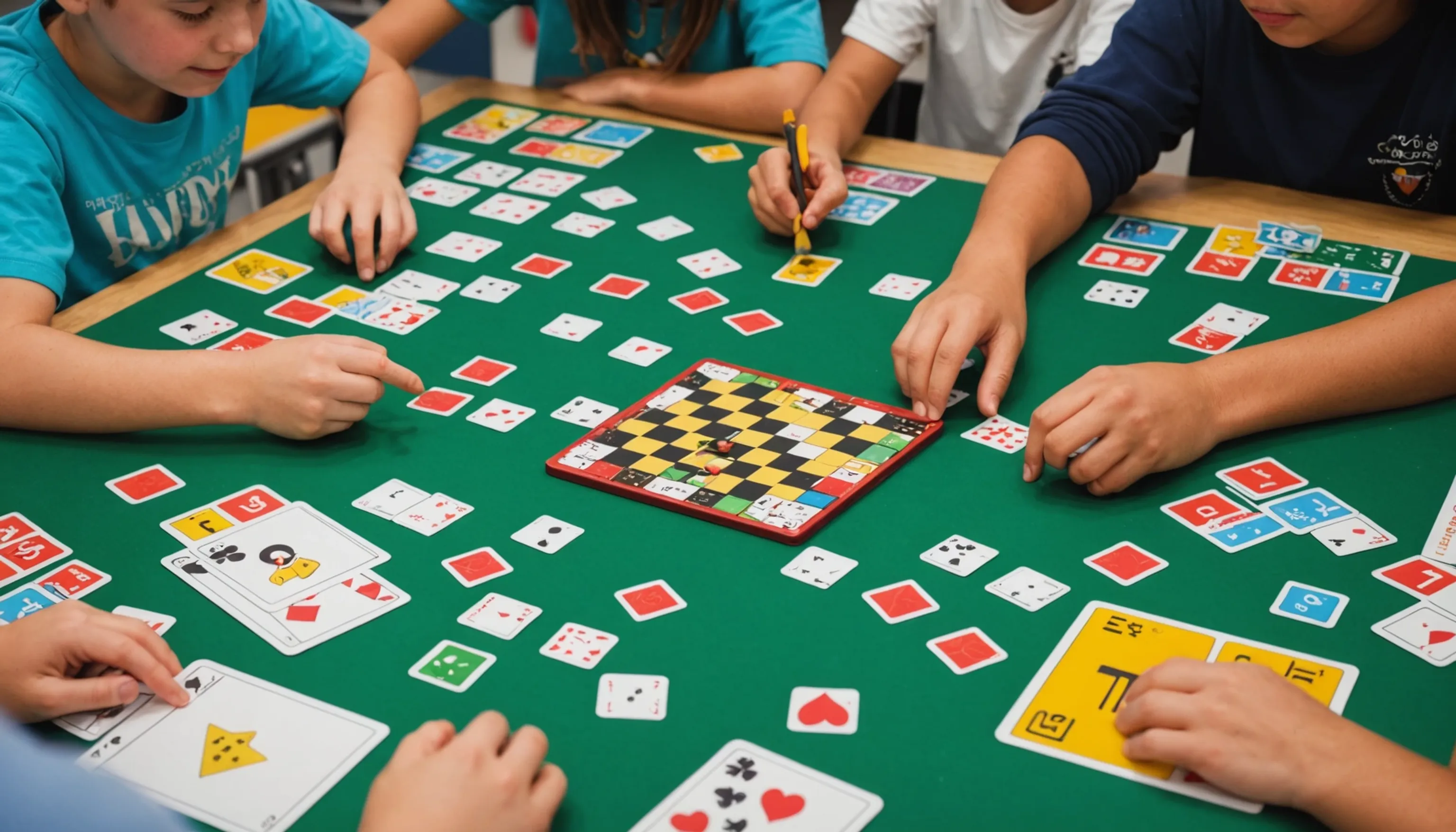Math Games to Motivate Students in Class
 HvWHenry van Wagenberg
HvWHenry van Wagenberg
Using Math Games to Motivate Students in the Classroom
Using math games in the classroom is an effective strategy to motivate students. These games make learning math enjoyable and engaging, transforming traditional lessons into interactive experiences. When students participate in games, they often feel less pressure and are more willing to take risks with their learning.
Games can cater to various skill levels, allowing students to progress at their own pace. They also encourage collaboration and healthy competition, which can enhance social skills and foster a positive learning environment. Ultimately, incorporating math games can lead to improved attitudes towards math and better academic performance.
Benefits of Math Games for Learning
Integrating math games into the learning environment offers numerous benefits for students. Firstly, these games enhance student engagement by providing a fun and interactive way to learn mathematical concepts. When students play games, they often become more invested in their learning, as the competitive aspect can drive them to improve their skills.
Moreover, math games promote critical thinking and problem-solving skills. Many games require students to strategize and make quick decisions, which helps develop their analytical abilities. This active participation fosters a deeper understanding of mathematical concepts, as students are not just memorizing formulas but applying them in real-time scenarios.
Another significant benefit is that math games can cater to different learning styles. Visual learners may benefit from board games with colorful pieces, while kinesthetic learners might excel in hands-on activities. This versatility allows teachers to reach a broader range of students, making math more accessible to everyone.
Additionally, using games can help reduce math anxiety. Many students fear failure or struggle with self-esteem when it comes to math. By incorporating games into lessons, teachers create a low-pressure environment where mistakes are seen as part of the learning process. This shift in mindset can help students build confidence in their math skills.
In summary, math games not only enhance student motivation and engagement but also foster critical thinking, accommodate diverse learning styles, and alleviate anxiety, making them a valuable tool in the classroom.

Types of Math Games to Engage Students
There are various types of math games that can effectively engage students and enhance their learning experience. One popular category is board games, which can be tailored to reinforce specific math concepts. For example, games like "Monopoly" can teach students about money management and basic arithmetic, while others like "Prime Climb" focus on number theory and prime factorization.
Another type of engaging game is card games. Simple card games, such as "Math War" or "Go Fish" with math operations, can help students practice addition, subtraction, multiplication, and division while having fun. These games can be easily adapted for different skill levels, allowing students to challenge themselves at their own pace.
Digital math games are also gaining popularity in the classroom. Platforms like Kahoot! and Prodigy provide interactive experiences that can be played individually or in teams. These games often incorporate quizzes and challenges that keep students motivated and excited about learning math.
Furthermore, hands-on activities, such as math scavenger hunts or escape room challenges, provide a unique way for students to apply their math skills in real-world scenarios. These activities require critical thinking and collaboration, making learning a social experience.
Finally, cooperative games encourage teamwork and communication among students. Games like "Math Jeopardy" or team-based challenges promote a collaborative spirit while reinforcing math skills. By incorporating various types of math games, educators can create a dynamic and engaging learning environment that caters to diverse student needs.
How to Integrate Math Games into Lessons
Integrating math games into lessons can enhance student engagement and understanding. Begin by selecting games that align with your curriculum objectives. Ensure that the games target specific skills or concepts you want students to master.
Introduce the game during a lesson to explain its rules and objectives clearly. You might even play a round together to model the gameplay. Consider dividing students into small groups to encourage collaboration and discussion.
Finally, debrief after the game to reflect on what students learned and how they can apply these skills in real-world situations. This approach not only reinforces learning but also makes math more enjoyable.

Choosing the Right Games for Different Topics
Choosing the right math games for different topics is crucial in maximizing their effectiveness in the classroom. First, consider the specific mathematical concepts you want to reinforce. For example, if you’re teaching fractions, games like "Fraction War" or interactive digital platforms that focus on fraction operations can be highly effective. These games allow students to practice and visualize fractions in an engaging way.
For topics like geometry, hands-on activities such as building shapes with blocks or playing games that involve spatial reasoning can enhance understanding. Games like "Tangrams" or "Geometry Bingo" can help solidify these concepts while keeping students actively involved.
When focusing on algebra, look for games that emphasize problem-solving and equation balancing. Board games like "Algebra Tiles" or digital games that challenge students to solve equations can help them grasp complex concepts in a fun environment.
Additionally, consider the age and skill level of your students when selecting games. Younger students may benefit from simpler, more visual games, while older students might enjoy strategic games that require critical thinking.
Lastly, don’t forget to incorporate games that promote collaboration and teamwork, as these can foster a positive learning atmosphere. By thoughtfully selecting games that align with your curriculum and engage students, you can enhance their understanding of various mathematical topics while making learning enjoyable.
Incorporating Technology in Math Games
Incorporating technology into math games can significantly enhance student engagement and learning outcomes. Digital games and interactive platforms provide a dynamic way for students to practice math skills while leveraging the appeal of technology. For example, educational apps like "Prodigy Math" and "Kahoot!" offer interactive quizzes and challenges that can be tailored to various topics and skill levels.
One of the primary benefits of using technology in math games is the immediate feedback students receive. Digital platforms can assess students’ responses in real-time, allowing them to understand their mistakes and learn from them instantly. This immediate reinforcement helps solidify understanding and boosts confidence.
Moreover, technology enables personalized learning experiences. Many math games adapt to each student’s skill level, providing customized challenges that ensure they remain engaged and appropriately challenged. This personalized approach is particularly beneficial in a diverse classroom where students may have varying levels of math proficiency.
Additionally, incorporating technology facilitates collaboration among students. Tools like Google Classroom or collaborative digital whiteboards allow students to work together on math problems, encouraging teamwork and communication skills. Furthermore, technology can make learning more accessible. Students can play math games on various devices, including tablets and smartphones, allowing for learning anytime and anywhere.
In conclusion, integrating technology into math games not only makes learning more interactive and enjoyable but also supports differentiated instruction and enhances collaboration among students, leading to a more effective learning environment.
Creating a Competitive Environment with Games
Creating a competitive environment with math games can significantly motivate students and enhance their learning experience. Competition encourages students to push their limits and strive for improvement. To foster this environment, consider implementing team-based challenges where students can work together to solve math problems or compete against one another in a friendly manner.
Using leaderboards to track progress and celebrate achievements can also boost motivation. Recognizing top performers not only rewards effort but also inspires others to engage more actively. Overall, a competitive atmosphere can make math fun while reinforcing essential skills.
Setting Up Math Competitions
Setting up math competitions in the classroom can be a fantastic way to engage students and reinforce their learning. To begin, define the structure of the competition. Decide if it will be individual or team-based, as both formats have their advantages. Team competitions promote collaboration, while individual contests can encourage personal accountability.
Next, determine the topics and skills to be covered during the competition. Ensure that the chosen material aligns with what students are currently learning in class. For instance, you might focus on arithmetic, geometry, or problem-solving skills. Create a variety of questions that cater to different difficulty levels, allowing all students to participate meaningfully.
To create excitement, consider incorporating a theme or a fun name for the competition. Promotional materials, such as posters or digital announcements, can help generate interest and enthusiasm among students. You might also offer small prizes or certificates to recognize participation and achievement, which can motivate students to do their best.
During the competition, set clear rules and guidelines to ensure fairness. Explain the scoring system and how winners will be determined. After the event, take time to celebrate the accomplishments of all participants. Provide feedback on performance and encourage students to reflect on what they learned from the experience.
By thoughtfully setting up math competitions, you can create an engaging environment that not only enhances students' math skills but also fosters a sense of community and camaraderie among peers.
Reward Systems to Encourage Participation
Implementing a reward system can significantly encourage participation in math competitions and games. A well-structured reward system motivates students to engage actively and strive for excellence. Here are some effective strategies to consider:
- Points System: Assign points for various achievements during competitions, such as correct answers, teamwork, or creativity. Accumulated points can lead to rewards.
- Certificates and Badges: Recognize participants with certificates or digital badges for accomplishments. These can be awarded for participation, winning, or showing improvement, fostering a sense of achievement.
- Classroom Currency: Create a classroom currency system where students earn 'math bucks' for their participation and performance. They can later exchange these for small prizes or privileges, such as a homework pass.
- Special Privileges: Offer winners the chance to lead the next game or choose the next topic for discussion. This inclusion fosters a sense of ownership and responsibility.
- Celebration Events: Host a celebration at the end of the competition, where all participants are acknowledged. Provide snacks or fun activities to make the event enjoyable.
By implementing a thoughtful reward system, you can create an engaging atmosphere that encourages students to participate in math games and competitions. This not only enhances their math skills but also builds a positive classroom community.
